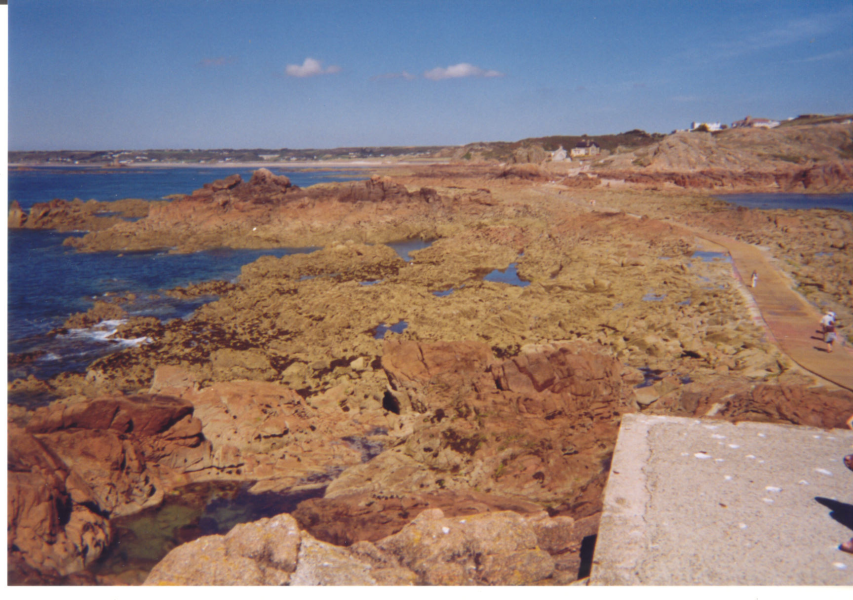La Corbière EarthCache
-
Difficulty:
-

-
Terrain:
-

Size:  (other)
(other)
Please note Use of geocaching.com services is subject to the terms and conditions
in our disclaimer.
Rock tidal flat near the causeway to and from La Corbière
lighthouse - inform about the tides before you approach!
A full moon over Jersey: the sea retreats up to 5km. Time for a "moon walk" on Jersey. Jersey is the place with the second highest tidal intervals in the world.
Jersey has been separated from the continent only 5000 years ago. That's why it is completely different from the other Channel Islands: the water surface is lower, the water temperature higher (about 4-5°C) and there is an anti-clockwise water circulation around Jersey.
The speed of the tides is impressive: the water retreats 3cm per minute. Thus, 32 square kilometers of tidal flats are created: Jersey doubles twice a day! (www.spiegel-online.de)
Tidal flats usually appear in an “nearly flat coastal area,
alternately covered and exposed by the tides, and consisting of
unconsolidated sediments.” There is a “level muddy
surface bordering an estuary, alternately submerged and exposed to the air by changing tidal levels. In addition to the alternating submergence and exposure, the varying influences of fresh river
water and salty marine waters cause physical conditions to vary
more widely than in any other marine environment. The mud of a
tidal flat is usually rich in dissolved nutrients, plankton, and
organic debris, and it supports large numbers of small animals such as crabs and worms. Vegetation is generally sparse, but mats of blue or blue-green algae (cyanobacteria) may be present.”
(www.answers.com)
The earth cache “Cape Cod Tidal Flats” (GC1E67W) deals
with the phenomenon.
But there are also rocky tidal flats which you can see near the
causeway to and from La Corbière lighthouse. As the water retreats in falling tide algae remain on the ground. Tidal inlets and tide pools create densely inhabited biotopes. The tidal pools are filled by sea water (even in ebb tide) in which you can find red, brown and green algae. Between these plants you can see crabs, shrimps, polyps and small fish.
Bladderwrack, a brown alga, creates an enchanting underwater world at flood tide. Numerous hideaways for animals are built up. At ebb tide the alga hangs down the rocks like a curtain and offers protection to small animals against enemies or drying out until the flood returns.
Blidingia minima, another alga, grows over the rocks. The green
alga creates its own miniature landscapes.
Algae have an enormous amount of biomass, making the plants an interesting object for the food industry.
Another aspect of the rock tidal flat of La Corbière is the
salinity of the water. Salinity (from Latin salinitas) is the
saltiness or dissolved salt content of a body of water. Due to
salinity you can divide aquatic biotopes into
· Salt water biotopes
· Brackish water biotopes,
· Sweet water biotopes.
Salinity is usually messured in gram per liter and the salt
concentration is given in per cent or per mille. Even small
differences of salinity have an influence on the concentration of
water (as temperature has as well). Salinity can change due to weather, climate or other conditions. On the one hand salinity in the tide pools in the rocky tideland near La Corbière increases as
the sea retreats at ebb tide. Indeed, salinity increases even more
as the water in the tide pools evaporates.
On the other hand sweet water like rain can lower the
salinity.
By the way: the average salinity of all the oceans is almost the
same.
Task 1: Take a picture of you and/or your GPS device, view towards the island of Jersey (as in pic4) - (Optional Task)!
Task 2: Take a photo of the causeway at high tide and one at low tide, please (as in pic 2 and 3)
Task 3: Estimate the tidal difference on both pictures and email your guess to us.

Additional Hints
(Decrypt)
Lbh pna bayl ragre gur rnegupnpur qhevat roo gvqr!